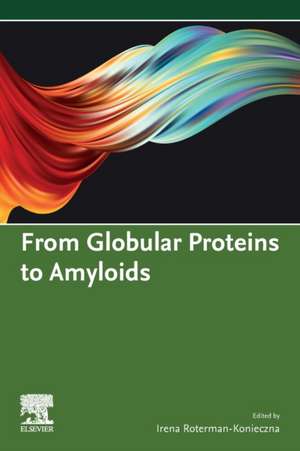From Globular Proteins to Amyloids
Editat de Irena Roterman-Koniecznaen Limba Engleză Paperback – 2 oct 2019
- Introduces basic rules for protein folding, along with the conditions that result in misfolding
- Presents research that lies in treating the aqueous environment as a continuum rather than a set of individual water molecules (i.e. the classic representation)
- Provides practical applications for helping the prevention of amyloidosis and improving drug design
Preț: 668.51 lei
Preț vechi: 734.63 lei
-9% Nou
Puncte Express: 1003
Preț estimativ în valută:
127.92€ • 136.79$ • 106.66£
127.92€ • 136.79$ • 106.66£
Carte tipărită la comandă
Livrare economică 10-24 aprilie
Preluare comenzi: 021 569.72.76
Specificații
ISBN-13: 9780081029817
ISBN-10: 0081029810
Pagini: 278
Dimensiuni: 152 x 229 mm
Greutate: 0.38 kg
Editura: ELSEVIER SCIENCE
ISBN-10: 0081029810
Pagini: 278
Dimensiuni: 152 x 229 mm
Greutate: 0.38 kg
Editura: ELSEVIER SCIENCE
Public țintă
Researchers interested in problems related to amyloid formation and protein folding/mis-foldingStudents of medicine, pharmacy and pharmacology where protein folding is taught as part of the basic biochemistry curriculum
Pharmaceutical companies which engage in R&D activities related to drug design
Cuprins
1. Description of the fuzzy oil drop model
2. Folding with the active participation of water
3. Information coded in protein structure
4. Gobular or ribbon-like micelle
5. Proteins structured as spherical micelles
6. Local discordance
6. A. The active site in a single-chain enzyme identified as local deficiency of hydrophobicity
6. B. Protein-protein interaction encoded as an exposure of hydrophobic residues on the surface
6. C. Ligand binding cavity coded in form of local deficiency of hydrophobicity
7. Solenoid – amyloid under control
8. Composite structures
9. Permanent chaperons
9. A. Non-amyloid structure of the aβ(1-42) polypeptide requiring a permanent chaperone
9. B. Structural properties of aβ(1-42) chain fragments in complex with proteins acting as permanent chaperones
10. Amyloids
10. A. Amyloid as a ribbon-like micelle
10. B. Alternative conformations of the aβ(1-40) amyloid protein
10. C. Specificity of amino acid sequence and its role in secondary and super secondary structure generation
11. Anti-amyloid drug design
12. Predicted structure of the transthyretin amyloid
2. Folding with the active participation of water
3. Information coded in protein structure
4. Gobular or ribbon-like micelle
5. Proteins structured as spherical micelles
6. Local discordance
6. A. The active site in a single-chain enzyme identified as local deficiency of hydrophobicity
6. B. Protein-protein interaction encoded as an exposure of hydrophobic residues on the surface
6. C. Ligand binding cavity coded in form of local deficiency of hydrophobicity
7. Solenoid – amyloid under control
8. Composite structures
9. Permanent chaperons
9. A. Non-amyloid structure of the aβ(1-42) polypeptide requiring a permanent chaperone
9. B. Structural properties of aβ(1-42) chain fragments in complex with proteins acting as permanent chaperones
10. Amyloids
10. A. Amyloid as a ribbon-like micelle
10. B. Alternative conformations of the aβ(1-40) amyloid protein
10. C. Specificity of amino acid sequence and its role in secondary and super secondary structure generation
11. Anti-amyloid drug design
12. Predicted structure of the transthyretin amyloid
